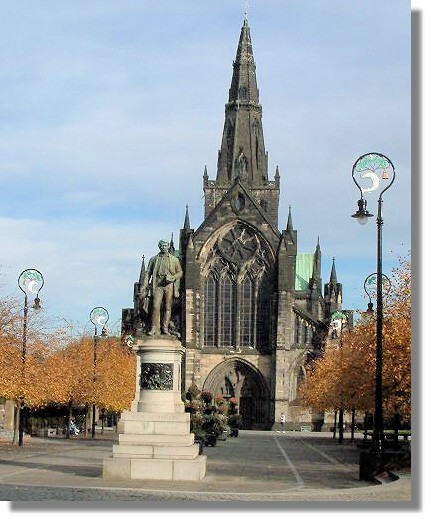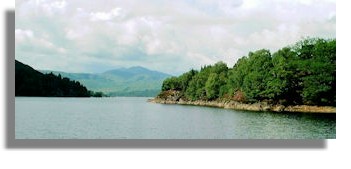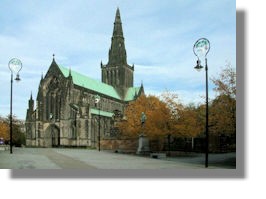The Scottish Snippets Newsletter in its original format began in April 1997 and continued in an unbroken series for 591 issues. Although no longer produced in that style, there is now this regular update on the new and updated pages on the Rampant Scotland site including "Scottie's Photo Diary From Scotland" and News and Views.
To receive a text version of this newsletter as a reminder to look at these Web pages when they are published, just send an e-mail to Scottie@RampantScotland.com with "Subscribe Newsletter" in the subject line.

Glasgow Cathedral and Statue of David Livingston
Moving House
For the first time in nearly 30 years my wife and I are moving house! Anyone who has done this knows how time consuming it can be. However, I have decided to try to continue the Rampant Scotland Web Site and the Newsletters. But I have decided to change the frequency from every 3 weeks to every 4. In addition, although there will be some entirely new pages (two new ones below) I am taking the "opportunity" to freshen up the graphics in particular from the early days of the site (some of which go back over 15 years). In those days, data com speeds were 56kb a second rather than the megabytes achievable today. So it was important then to keep the size of graphics as low as possible. So a project that has been on my "to-do" list for a while to add to the graphics and replace the existing ones with larger formats can now move forward. I hope you enjoy the "upgrade"! Graphic of a Pickfords removal van © Mark Hillary via Wikimedia Commons
Places to Visit - Loch Katrine
Made popular by Sir Walter Scott's novel "Lady of the Lake", Loch Katrine was (and still is) a major source of the water supply for Glasgow over 26 miles away due to a far sighted project in Victorian times. The water travels along a large diameter pipe to Milngavie just north of Glasgow using just gravity and now delivers over 65 million Imperial gallons per day. See: Places to Visit - Loch Katrine
Places to Visit - Glasgow Cathedral
The original cathedral was built on the banks of the Molendinar Burn a tributary of the river Clyde by St Mungo but the first building was destroyed by fire. The present cathedral was started in 1197 but was expanded and reconstructed in the 15th century. The cathedral is 285 feet long and has an open timber roof dating from the 14th century. See: Places to Visit - Glasgow Cathedral
Battle of Halidon Hill (1333)
Despite being driven out of Scotland, Edward Balliol made another attempt to gain the throne of Scotland. This time the English King Edward III marched north himself and laid siege to Berwick. A relief force, under Archibald, lord of Douglas, was confronted by the English army on the slopes of Halidon Hill. Douglas had a numerically superior army but the English longbow men decimated them. Berwick fell soon after. See: Battle of Halidon Hill (1333)
Learning Scottish Gaelic: A Personalised Method
In 2011, only 1.1% of Scots (57 000 people) reported an ability to speak the language. But there are many reasons to take the plunge and start learning. Its grammatical 'quirks'; an almost stress-inducing eight forms of definite article, for example; make it a linguist's dream (or nightmare?). Even if you are only curious about the "language of the angels" it is worth a look and listen! See Learning Scottish Gaelic: A Personalised Method
Next Newsletter
The next newsletter is scheduled for four weeks from now on 26 August and will be mainly Current News and Events in Scotland from David, the News and Views Editor.
Of course, if you have any Scottish memories which you would like to contribute to "Memory Lane" please send them in!
Yours aye
Scottie
Previous editions of this Newsletter are available in an Archive. The Index to the other pages of the Rampant Scotland site is available here.
Where else would you like to go in Scotland?






